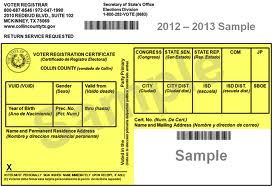Still the only voter ID anyone should need
Texas has been one of the nation’s fastest-growing states since the 1970s, but its voter rolls have at times been stagnant. From 2000 to 2012, the number of registered voters grew by 1.2 million. In only the last four years, the state has added that many voters and more, contributing to the state’s growing competitiveness.
One reason for the recent spike of nearly 1.4 million additional voters is that advocacy groups have learned to work efficiently within the state’s strict rules for registering new voters and have invested money and time in mass voter drives.
“No state makes it as difficult as Texas to register voters,” said Cristina Tzintzún Ramirez, the founder of Jolt who is now the executive director of a national voter registration group called NextGen America.
State Sen. Bryan Hughes, R-Mineola, said the state is only trying disincentivize cheating so voters have confidence that the process is fair.
“We hope when people see that the system is safe, they will be even more likely to participate,” he said.
[…]
In 2013, campaign operatives who previously worked for President Barack Obama launched a group called Battleground Texas. Their mission was to navigate the minefield of Texas voter registration laws to grow the voter rolls. Despite the barriers, Battleground Texas and other groups started to make headway in signing up voters. Other groups joined the effort over the coming years, including Jolt, The Lone Star Project and Be One Texas.
Tzintzún Ramirez said the focus now is on registering younger voters in Texas, between the ages of 18 to 35, who traditionally have some of the lowest registration rates.
“If we look at closing the registration and turnout gap we had to focus on young people,” she said.
[…]
At first Republican groups scoffed at the work of Battleground Texas and Jolt. But as the state’s voter registration has boomed and races have gotten closer, the GOP started responding more aggressively.
Going into 2020, a handful of GOP donors started a super PAC called Engage Texas with the goal of educating and registering Texas voters. The Republican Party of Texas also announced its own initiative called the Volunteer Management Project, which includes longtime Texas GOP strategist Karl Rove, aimed at getting potential Republican voters registered.
They use analytics programs to track people moving to Texas from other states to determine whether they were registered Republicans or voted in GOP primaries in other states. From there, volunteers mobilize to reach out to those potential voters to get them registered and make sure they turn out to vote.
Dave Carney, a top political advisor to Gov. Greg Abbott and Rick Perry before him, said it speaks to a new reality in Texas with a constantly changing electorate that looks different from one presidential election cycle to the next.
“Every campaign is a new campaign,” he said. “What you did last time has no impact on the future. If you want to sit on your past success, pretty soon you’re going to be lamenting the good old days.”
Sen. Hughes’ words are transparently self-serving bullshit, but that’s to be expected. Dave Carney is evil, but he understands the environment he’s in and has been making adjustments. Voter registration growth is a good thing, but that doesn’t mean it’s all to the benefit of one party.
This companion article gets into the numbers.
Texas has surpassed 18 million registered voters for the first time as an increasingly urban and diverse population reshapes the state’s political landscape and pushes the GOP to retool its decades-old playbook to keep a grip on the state.
The state’s voter registration rolls are expanding at a quicker pace than other fast-growing southern states like Florida, North Carolina and Georgia. And they’re surpassing the state’s population growth, a sign that more than just new Texans are signing up to vote.
Since U.S. Sen. Ted Cruz was last on the ballot in 2018 and narrowly won reelection by just 215,000 votes, Texas has added nearly 2.6 million voters — the size of Connecticut’s entire voting rolls.
There’s more, some of which will be quite familiar if you’ve been reading here for awhile, so read the rest. A bit of context here, in 2020 there were 11.3 million votes cast out of just under 17 million registered voters, for 66.7% turnout. With 18.4 million voters now, at that same turnout level there would be about 12.3 million votes cast. Assuming a couple hundred thousand for the minor candidates, the winner in this state will need about 6 million votes. That’s a heck of a lot, but do bear in mind that State Supreme Court Justice Jane Bland hit that number in 2020. Joe Biden got over 5.2 million, a nice achievement but a long way to go. Keep that 6 million mark in mind, and also keep in mind that it could easily be too low. There’s plenty of work to be done.

